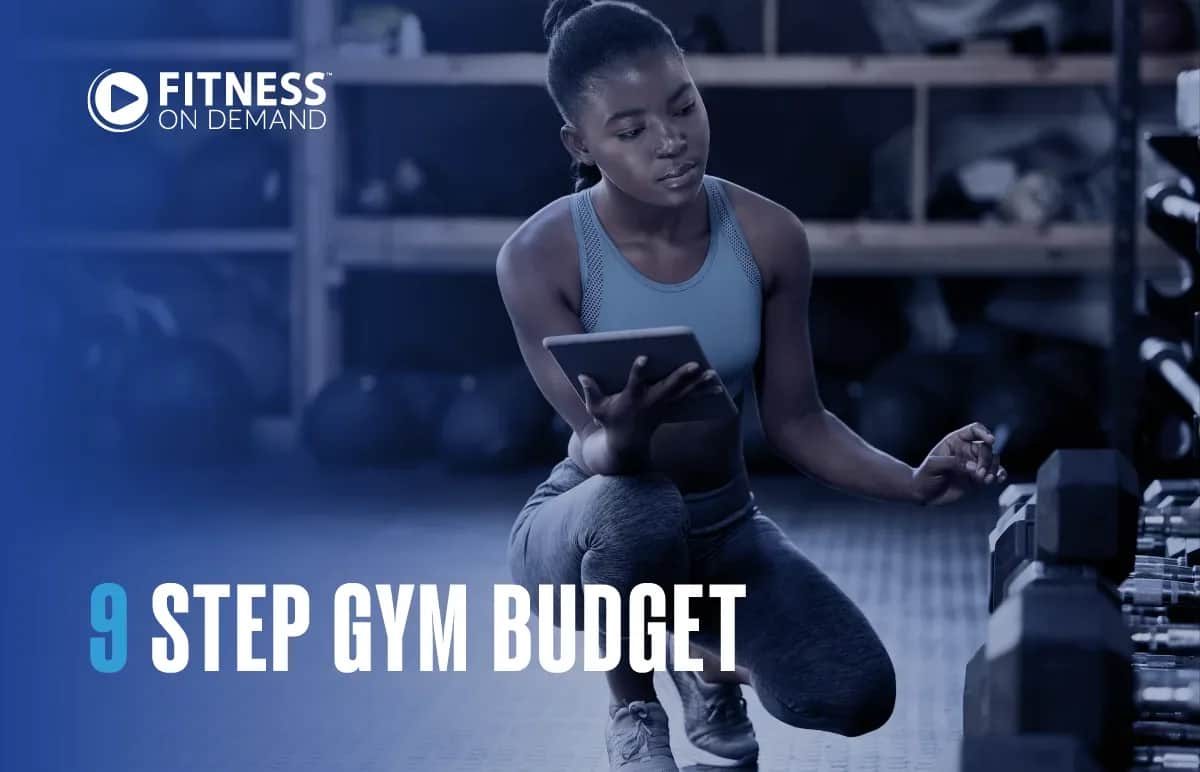Opening a gym or health club is exciting, but before you dive in, you need a solid financial plan. Creating a gym budget is the best way to map out your spending, understand your potential earnings, and set yourself up for success.

Whether you’re starting from scratch or refining your existing setup, this guide will walk you through the steps to create a gym budget that covers all the bases and helps maximize your return on investment. Ready to get started? Let’s break it down.
1. Analyze Your Current Financial Situation
Before anything, you need to assess where you stand financially. Look at your current cash flow, existing loans, and financial commitments. Understanding this will give you a clear picture of how much wiggle room you have and where you might need additional funding.
2. Set Your Financial Goals
Once you know where you stand, the next step is to set clear financial goals. These goals will guide your gym budget and influence your decisions. Are you aiming to break even within a year? Do you have plans to expand your equipment lineup?
Defining these goals will help you prioritize your spending and align your financial plan with your long-term vision. Be specific and realistic—this will make your budget more actionable.
3. Identify Key Expenses
When creating your gym budget, you must account for both one-time and recurring costs. To give you a comprehensive view of what to expect, we’ll break down the key areas you’ll want to focus on.
Equipment Costs
Gym equipment is one of the biggest investments you’ll make. The cost of gym equipment depends on whether you’re opting for brand-new machines or choosing to buy secondhand.
On average, expect to spend between $15,000 and $50,000 for a fully outfitted gym, but this can vary widely depending on the type and quantity of machines. When planning your gym equipment budget, factor in the cost of cardio machines, weightlifting equipment, and smaller items like mats and dumbbells.
Plan to spend another $8,000 to $20,000 to furnish the space, including the front desk and other non-fitness equipment.
Licenses and Permits
To get started, you’ll need to register your gym with the state, costing between $150 to $500. You’ll also need to secure local permits like health and safety, zoning, and occupancy certificates. Costs vary by location but typically range from $1,000 to $2,000.
Staff Salaries
Your team will likely be your biggest ongoing expense. On average, gym owners spend $60,000 to $96,000 annually on staff salaries, but this will depend on your location and the number of employees.
Personal trainers, front desk staff, and maintenance crew should all be in your staffing budget.
Ongoing Operational Expenses
From utilities to marketing, gyms incur a variety of operational expenses. It’s important to factor in the average cost of utilities such as electricity, water, and heating/cooling and ongoing marketing efforts to attract new members. Don’t forget cleaning supplies and repairs, which can add up quickly.
Monthly ongoing costs for a gym include:
- Rent or mortgage
- Payroll
- Utilities
- Maintenance
- Equipment
- POS software
- Marketing
4. Prepare for Initial Startup Costs
In addition to ongoing expenses, there are significant upfront costs that you’ll need to account for when first setting up your gym. The average cost to set up a gym can range from $50,000 for a basic facility to over $1,000,000 for a full-scale gym packed with premium amenities.
Many gyms and fitness centers operate as part of a franchise. If you go this route prepare for purchase fees typically ranging from $20,000 to $50,000.
Lease Deposits
Securing a commercial lease will often require a deposit and the first few months of rent upfront. Depending on the size and location of your gym, security deposits can range anywhere from about $20,000 to $45,000.
Remodeling Costs
Whether you’re converting an old space or building from the ground up, remodeling can be a big-ticket item. Expect to spend anywhere from $20,000 to $115,000, depending on the extent of the work needed. This includes setting flooring, mirrors, lockers, and other cosmetic changes to create the right atmosphere for your clients.
Essential Gym Gear
In addition to major equipment, you’ll need to budget for smaller essentials like towels, water coolers, and first aid supplies. While these might seem minor, they’re important details you shouldn’t overlook when planning your comprehensive business plan.
5. Allocate Funds for Variable Expenses
Every gym will have some variable expenses, which can fluctuate from month to month. Variable costs include things like member services, equipment repairs, and special event costs. It’s wise to set aside a portion of your gym budget to handle these miscellaneous expenses as they come up.
For instance, repairs for gym equipment might set you back a few hundred dollars each time something needs fixing, so be prepared.
6. Develop Revenue-Increasing Strategies
Boosting your gym's revenue is just as important as managing expenses. A well-thought-out plan to increase income will help you cover costs, expand your offerings, and ensure long-term success.
Membership Pricing Models
Your membership pricing structure forms the backbone of your gym's revenue. Offering multiple pricing tiers not only makes your gym more accessible but also allows you to cater to different customer needs. Here are a few options to think about:
- Basic memberships: These can attract price-sensitive clients who only want access to the facility during off-peak hours or prefer minimal amenities. Pricing can range from $38 to $75 per month, depending on location.
- Premium memberships: For those who want full access, including premium amenities like saunas, group classes, or specialized equipment, you can charge more for higher-tier membership options.
- Family or group packages: Consider offering discounted rates for families or groups. This can attract multiple members from the same household or friend groups, increasing your gym membership sales without a significant increase in operational costs.
- Corporate memberships: Partner with local businesses to offer discounted or tailored packages for their employees. Corporate memberships can be an excellent source of recurring income, especially if you can lock in contracts with larger organizations.
Promotional Offers
Running promotions can help you bring in new members and retain existing ones. Well-timed promotions are a great way to boost sales without needing to drastically cut prices or compromise on the value you offer. Here are a few ideas:
- Seasonal discounts: Offer discounts during the slow seasons (like summer or post-holidays) when people might be less likely to join a gym. A discounted first month or a waived sign-up fee can help bring in new members.
- Referral programs: Encourage your existing members to refer friends or family by offering discounts, free classes, or other perks. Referral programs can be a low-cost, high-reward strategy to increase your membership base.
- Trial memberships: A free or discounted trial period, such as a 7-day pass, allows potential members to experience your gym firsthand. These short-term offers often convert into long-term memberships once people get a taste of what your facility has to offer.
Bundling Services and Technology
Bundling services like digital signage, virtual classes, and entertainment solutions saves money while boosting member satisfaction and streamlining operations, helping to increase revenue. Instead of juggling multiple subscriptions, a bundled package offers:
- Cost savings: Combine services to reduce fees and simplify management by working with a single provider like Fitness On Demand.
- Unified member experience: Provide a seamless, integrated platform where members can access everything from class schedules to virtual workouts.
- Extensive class library: Access a wide range of on-demand and live-streamed fitness classes tailored to your members' needs.
- Compatible Systems: One comprehensive platform offers accountable compatibility reducing issues like connectivity or integrability.
Personal Training Services
Personal training is a significant revenue driver for many gyms. Offering personal training sessions or small group training provides an opportunity to earn more without increasing membership fees.
You can charge anywhere from $25 to $100+ per hour for one-on-one personal training, depending on your location and the qualifications of your trainers. It's also a good idea to offer discounted rates for members who buy packages of 10 or more sessions. Bundling services this way supports your gym cash flow optimization and encourages clients to commit to regular sessions.
7. Create a Budget Template
With all your expenses and revenue streams in mind, it’s time to organize everything into a clear budget template. You can use a simple spreadsheet or invest in gym-specific software to track your costs and income over time.
A gym budget example might include initial expenses like equipment purchases, lease deposits, and remodeling costs, as well as ongoing costs such as staff salaries, utilities, and maintenance. Breaking these down will give you a clear picture of your financial plan and keep you prepared for both fixed and variable expenses.
8. Monitor and Review Your Budget Regularly
Creating a gym budget isn’t a one-time thing — it’s something you’ll need to revisit regularly. Your financial situation will evolve as your gym grows, and keeping an eye on your cash flow will help you make adjustments as needed.
Review your budget every quarter to see if you’re on track, and don’t hesitate to make tweaks to account for changes in your business or unexpected expenses.
9. Adjust Your Budget for Growth and Changes
As your gym expands or your member base fluctuates, your budget will need to adjust, too. Perhaps you’ll need more staff or want to invest in new equipment to keep up with demand. By staying flexible, you’ll be able to adapt to new challenges and continue optimizing costs.
Optimize Costs and Increase Gym Membership Value With Fitness On Demand
Maximizing your gym’s potential starts with a solid budget and smart revenue strategies. By planning carefully and diversifying your income streams, you can set your gym up for long-term success.
Ready to enhance your gym’s offerings and keep members engaged? Fitness On Demand provides cutting-edge virtual fitness and wellness solutions designed to fit any space or schedule. Reach out today to see how our digital fitness platform can help you attract more members and grow your business.

Author
Todd Wiginton
Todd Wiginton is a seasoned fitness professional with over a decade of experience in the industry, currently serving as the Sr. Director of Operations at Fitness On Demand. His career, marked by roles such as Personal Training Manager and Strength and Conditioning Coach, showcases his dedication to fostering personal and professional growth in ever-changing environments.
